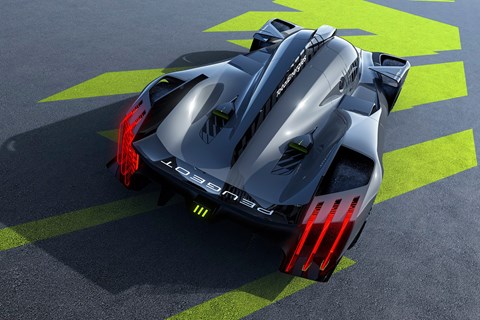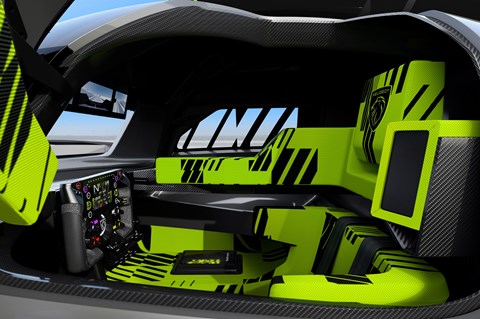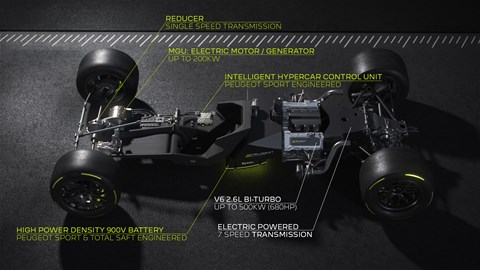► Stunning hybrid to hit the track in 2022
► Can Peugeot's LMH contender continue past success?
► Racer to help develop and market passenger hybrids
The new WEC Hypercar class is the most exciting thing to happen to endurance racing in years – and now Peugeot's kicked the Le Mans renaissance into hyperdrive with the unveiling of its stunning 9X8 LMH contender.
An outrageous closed-cockpit racer, the 9X8's aesthetic is the result of an internal Peugeot design competition. The winner carries much of the menace of Peugeot's most successful Le Mans car, the 905 that won in 1992 and 1993, and mixes in plenty of current Peugeot and Sport Engineered cues.
The latter is key to the business model, with Peugeot CEO Linda Jackson insisting a return to endurance racing is both the ideal R&D lab for new hybrid technology, and the perfect arena in which to demonstrate Peugeot's 'excellence in hybridisation and combustion' and 'total reliability'. As well as winning, the 9X8's job on track will be to market what Jackson describes as Peugeot's 'energy transition' – 70% of Peugeot's offering will be electrified by the end of this year.

The car unveiled is a faithful representation of the finished racer that'll hit the track in testing later this year. The surfaces may evolve a little, particularly as Peugeot Sport develops the car's wing-less aerodynamics. There's no wing because the 9X8 was able to hit the required level of downforce without one – innovative solutions in the bodywork will allow the team to tweak the car's aero balance during set-up work.
Technically, as Peugeot's already confirmed, the 9X8 combines a 2.6-litre, 90° turbo V6 driving the rear axle with a 268bhp front e-motor (teamed with a 900-volt battery) for all-wheel drive and a combined output bang on the regulation maximum of 670bhp.
The new rules are prescriptive but have worked in attracting a bunch of manufacturers back to the WEC and Le Mans. Toyota is in, Ferrari will race come 2023 and Glickenhaus is also readying its Hypercar. Audi and Porsche will also join the fray, in the slightly less exotic but more affordable LMDh class.

Part of the appeal is undoubtedly the chance to win the 100th anniversary running of the 24 Hours of Le Mans, in 2023. The 9X8 may race at Le Mans in 2022 but Peugeot Sport is eyeing the big prize and wants everything right for 2023. Regulations also mean that, once a car is homologated, evolving it is all but impossible for the duration of Pug's commitment, which stretches to 2025.
A road-legal, limited-run 9X8 road car, to sit in your garage next to that Toyota GR010 you have on order? 'Far, far too early to say,' says Jackson: 'We want to win first.'
Peugeot 9X8 powertrain explained
Peugeot has revealed details of the hybrid powertrain that’ll sit in its forthcoming WEC car. Called the Peugeot Hybrid4 500KW, it’ll consist a formula we’re getting more used to: a V6 turbo along with a beefy electric motor.
In this case, Peugeot has opted for a twin-turbo 2.6-litre V6 that’ll drive the rear wheels with 500KW or 671bhp. It’ll be mid-mounted, weigh 165kg and will be mated to a sequential seven-speed ‘box. The front axle is powered by 200KW or 268bhp motor, that Peugeot is adamant has been developed with road car expertise.

WEC rules currently cap this progressive element of the car at 200KW, but this’ll likely be down to cost-saving.
So far, so simple
The car is capped to 500KW at almost all times; that means when the 200KW front-mounted electric motor is engaged, the ICE can produce no more than 300KW. Further rules mean the electric motor can only be engaged above 74.6mph - except in the pits where speed is restricted to just 37.2mph. In that case, EV power, petrol power or a combination of the two is apparently fine.
Finally, hypercar rules do allow the system to ICE to run at 515KW, but only at the end of straights when the battery is depleted. In this sense, it can be seen as an 'alternator mode.'
Like F1’s hybrid system, this motor will be able to capture energy via a sophisticated brake-by-wire system, but unlike the one used by Mercedes-AMG et al this year, it’ll give the car four-wheel drive capability when deployed.
A high-performance 900V battery is at the heart of these energy transactions; encased in a carbon cell within the monocoque it’s designed cope with huge power transfers for a 24-hour period. It’ll be assembled by Peugeot Sport in a new facility outside Paris, but homologated by Total.